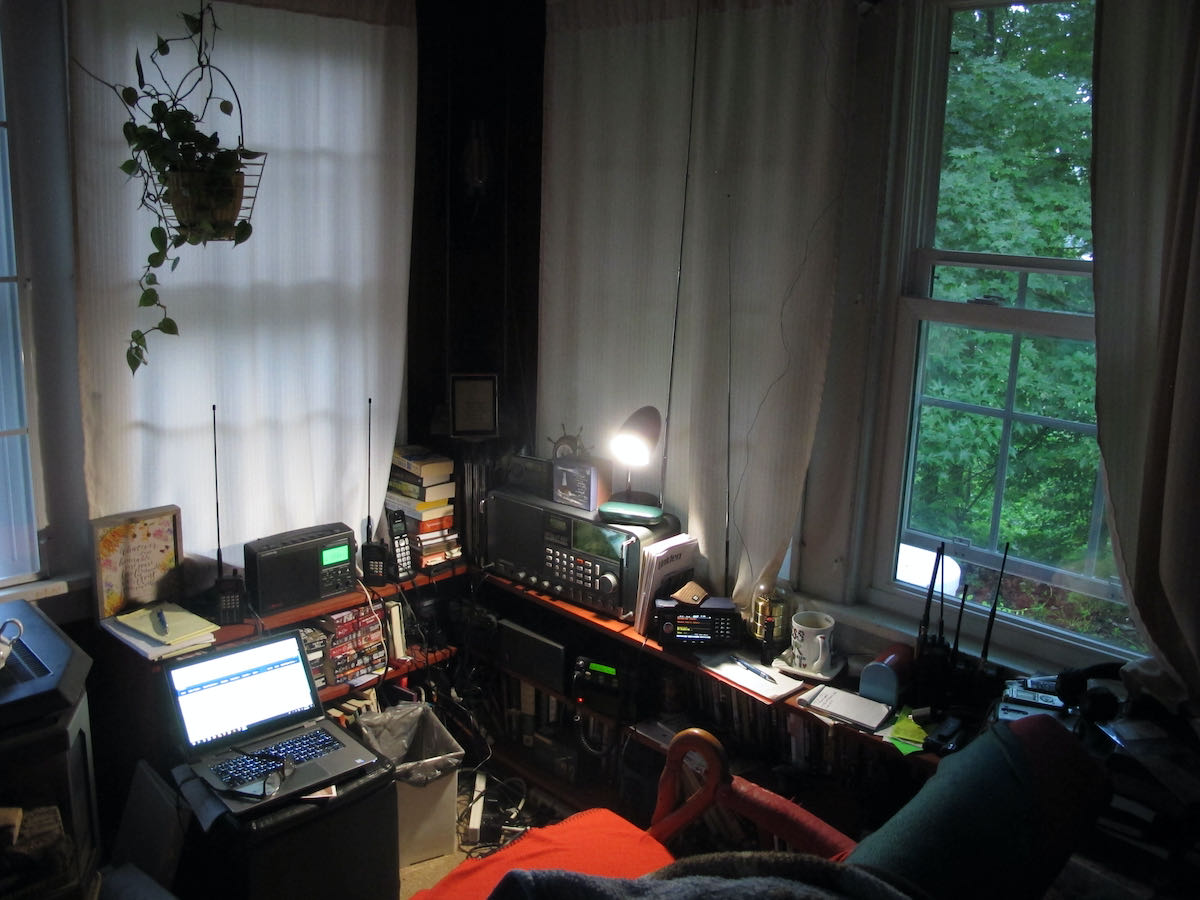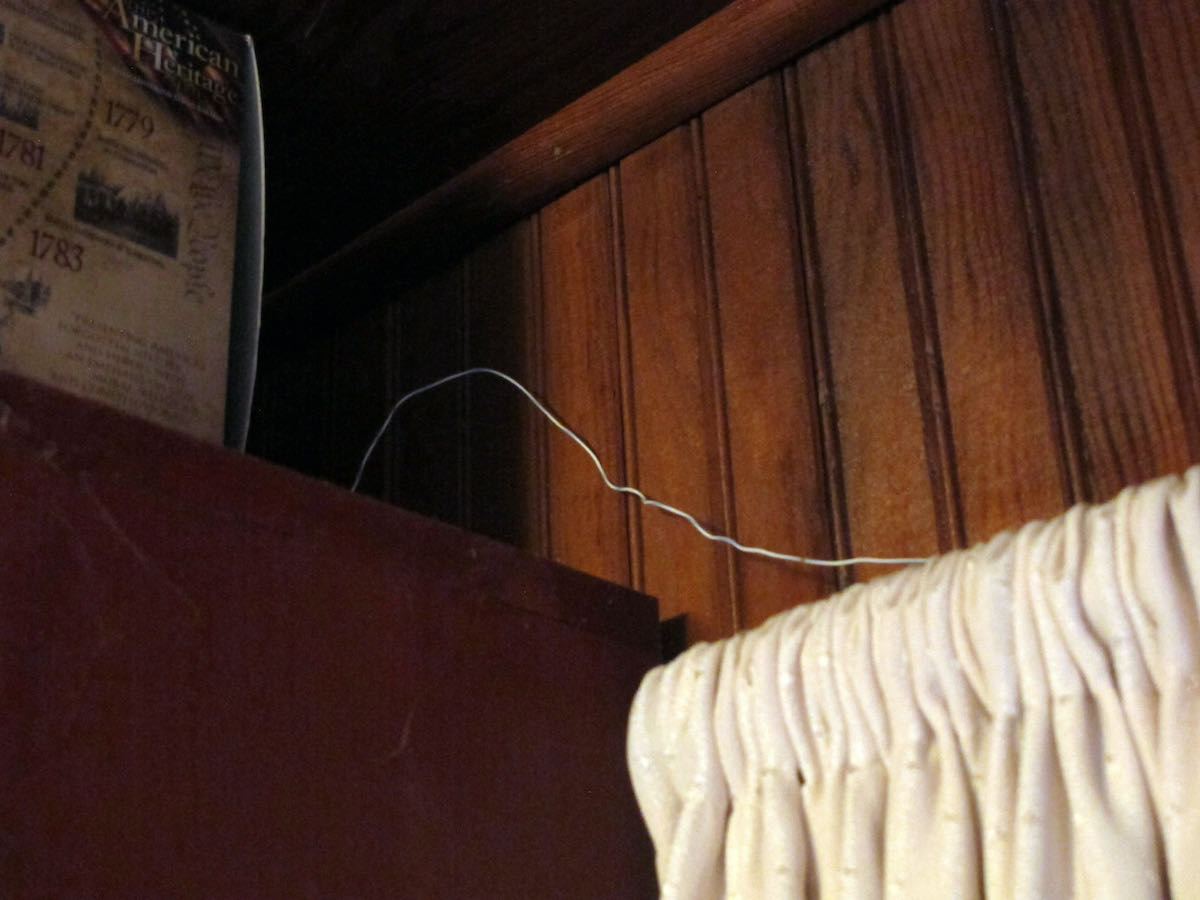Many thanks to SWLing Post contributor, Jock Elliott, who shares the following guest post:
Got reception issues? An idea worth considering: the “Horizontal Room Loop.”
by Jock Elliott (KB2GOM)
When my radio room was in the front of the house (on the east side), it was easy to run a feedline to a large RF-hungry SWL dipole with various stubs and feeders.
Now, however, with my “shack” moved to the SW corner of the house, any attempt to mount an outdoor antenna of any significant length raised potential safety issues because of nearby electrical lines.
Monitoring VHF/UHF is no big deal because of high-performance scanner antennas. HF, however, presents challenges.
My main SWL receiver is a Satellit 800, which has the guts of a Drake R8 and also has a large telescoping vertical antenna. It works okay, but I wanted more signal. I had been looking at small loops and got some great recommendations on Radio Reference, but then I had a thought: what if I turned the 8′ x 12′ room into a giant horizontal passive loop?
So I called a ham friend and ran the idea by him. “Sure,” he said, “give it a try.” He gave me 25 feet of 4-conductor phone wire. Before I could use it, I had to strip off the outer insulation so I could get at the four separate insulated wires inside. The better half helped. Once I had the four wires, I connected two of them together and ran the resultant 50-foot strand around the perimeter of the room by taping the wire to the top of window frames and hiding the wire on the top shelves of book cases. As a result, the horizontal room loop is near the ceiling, about 7 feet in the air, and the room itself is on the first floor.
With the loop in place, I hooked the ends to the clip-in terminals on the back of the Satellit 800.
There’s a switch on the back of the 800 that allows me to quickly compare the loop with the radio’s built-in vertical antenna. And . . . it works! It pulls in more signal than the vertical (as measured on the signal strength meter), but I have not noticed a dramatic reduction in noise. On some stations, the horizontal room loop brings the signal up to full scale, and then the sound is very agreeable indeed.
In all, I am pleased with the results.
For anyone who wants squeeze more performance out of their shortwave receiver, I can recommend giving the horizontal room loop a try. It’s not expensive; it’s relatively easy to do (and undo if you don’t like the results), and just might improve your shortwave reception.
If you are not blessed with a bunch of window frames on which you could tape the wire for your room loop, you’ll have to get creative, but with lightweight wire, you don’t need a massive support structure. Tape, map tacks, or even self-adhesive Velcro segments might work for putting your room loop in place.
I don’t claim that this is the “ultimate” SWL DX antenna, but it certainly improved my situation. Perhaps others have suggestions for improving it.
— Jock Elliott, KB2GOM



Hi. I am in the proses of running a Bell wire loop around my Ceiling my small room is 6 feet X 6 Feet how many times must I go around the Ceiling & do I need a Balun.
Many thanks Michael-UK.
I have been a big fan of Horizontal loops for several years now.
I have gotten consistently better results from MLA-30, Sony ANLP1, YouLoop, etc.
Horizontal looping gives me More Signal, Less Noise, and Omnidirectional reception.
I haven’t done any exact measurements, but Eyes and Ears tell me it’s a Win-Win.
I’m surprised that more people don’t know about this.
I constructed a similar ceiling loop using electric fence wire (the plastic woven stuff with stainless steel wires embedded in it). Two loops about 150mm apart, crossing over above the drop point, so there was a total of around 100ft of wire around the ceiling perimeter.
This arrangement made a huge difference to my ability to be able to pick up distant broadcasters on a simple Grundig SW portable.
Dave,
I just noticed you comment today. Verrry interesting!
Cheers, Jock
For in-house reception a loop antenna is very preferable as it picks up much less noise from the house.
But I feel that a very important part is still missing from this antenna: A common-mode yoke! The antenna has quite some capacity to the surroundings that might couple electrostatic fields into the antenna.
Get a ferrite ring and give the double wire to the receiver several windings through the ferrite ring. It might even help to insert one ring at the feeding point of the antenna and another one at the receiver.
Alexander,
I am going to display my ignorance: what is a common-mode yoke?
Cheers, Jock
Hello Jock,
you will find it with several more names:
* Get a ferrite ring large enough to feed several turns of your cable from the antenna to the receiver through it. The material is not so important.
* Put as many turns on the ferrite ring as you can without any turn over another one.
The function of this:
“Symmetric” currents from the antenna to the receiver see a bifilar coil. the magnetic fields of both currents compensate each other. the ferrite ring “sees” no current that could put energy in its magnetic field. These currents can travel through without problems.
Any “unsymmetric” currents from the antenna to the receiver “see” the inductance of the coil on the ferrite ring. They are greately reduced. In other words: They have a large resistance in their way. This is especially true for currents that are coupled from the house wiring to the antenna.
See for example https://www.dj0ip.de/rf-cmc-chokes/different-kinds-of-chokes/
Hi Jock.Please explain why you stripped the outer insulation core off,to get to the already insulated telephone wires?You tided two wires together ran them arround your room and connected them to the clips of your receiver.What did you do with the other two wires? It makes the perfect loop but Im puzzled why you just didnt run the whole loom arround the room and tied the whole 4 wires together and connected them to the clips. I too have receiption problems,and alot of electrical interferance.Thanks from New Zealand.
James,
I was given approximately 25 feet of phone wire. It was not long enough to go all the way around the room. It has an outer plastic sheath, and inside that sheath are four individual insulated wires. I knew that the room is 8 feet by 12 feet, so I figured I needed at least 40 feet of wire to cover all four walls of the room, plus some additional wire to reach from the loop to the back of the receiver. So I had to connect two of the individual insulated lengths (each 25 feet) together to make the necessary 50 feet.
As to “What did I do with the other two wires?” I coiled them up and saved them for the next project!
Jack,
Very Nice.
I have something similar. Only I used standard 2-pair speaker wire. I have it running around the two second story bedrooms, down each side of the upstairs hallway, then over to the high windows in the living room, finally ending up on the dining room table. It works great for reception.
Earlier, this year, I attached a 9 to 1 balum to one end and then to my Yaesu FT-817. I made some contacts on 80-20 meters, all on five watts. I was surprised that it even worked. For several weeks, I used this setup to check into the PA, NY and NJ NBEMS digital nets.
The speaker wire works great. My outdoor end-fed antenna is made from 90 feet of speaker wire. I just solder the ends together. And it makes for an almost invisible wire which is very strong. A lot easier than using phone cable.
73
Bill WD9EQD
Smithville, NJ
Excellent!
Cheers, Jock
I had a similar setup in the basement apartment where I lived during grad school. It worked surprisingly well.
I, too, am and surprised and pleased.
Brothers of the horizontal room loop (and sisters) unite!
Cheers, Jock
Thanks for sharing this, Jock! I once made a very similar loop when I lived in an old farmhouse with noisy dimmer switches. It helped knock down the RFI a notch or two and also increased gain over simply using a vertical whip.
And as you say: this is a very affordable and low-profile antenna experiment that anyone can try.
Thanks again!
Thomas
My pleasure!
Cheers, Jock